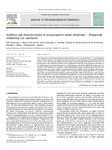Synthesis and characterization of poly (propylene imine) dendrimer–Polypyrrole conducting star copolymer

View/
Date
2010Author
Baleg, Abd Almonam A
Jahed, Nazeem M
Arotiba, Omotayo A
Mailu, Stephen N
Hendricks, Nicolette R
Baker, Priscilla G
Iwuoha, Emmanuel I
Metadata
Show full item recordAbstract
A star copolymer based on poly(propylene imine) (PPI) dendrimer core (generations 1–4) and polypyrrole (PPy) shell was prepared. The synthesis procedure involved a condensation reaction between PPI surface primary amine and 2-pyrrole aldehyde to give the pyrrole-functionalized PPI dendrimer (PPI-2Py). The pyrrole units on the dendrimer backbone were polymerized chemically using ammonium persulfate as an oxidizing agent and electrochemically on a coated platinum electrode with PPI-2Py using cyclic voltammetry. The resulting star copolymer, called poly(propylene imine)-co-polypyrrole (PPI-co-PPy) was characterized using nuclear magnetic resonance spectroscopy (NMR), Fourier transform infrared spectroscopy (FT-IR), thermogravimetric analysis (TGA), scanning electron microscopy (SEM), X-ray diffraction (X-RD) and electrochemical impedance spectroscopy (EIS). NMR of PPI-2Py gave a new chemical shift at 8.1 ppm for NCH, which confirmed the incorporation of 2-pyrrole aldehyde into the PPI dendrimer structure. Strong FT-IR bands appeared at 1634 cm−1 for ν(NC) in the dendrimer moiety, and at 729 cm−1 for ν(CH) at the α-position of the PPy ring. The PPI-co-PPy exhibited improved thermal stability than PPI-2Py and ionic conductivity over pristine polypyrrole as interpreted from the TGA and EIS profiles respectively. Hall effect measurements showed that the star copolymer is a semiconductor with an electronic conductivity of 0.7 S cm−1.
